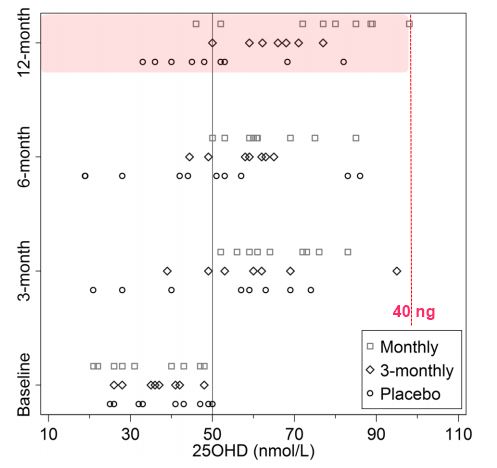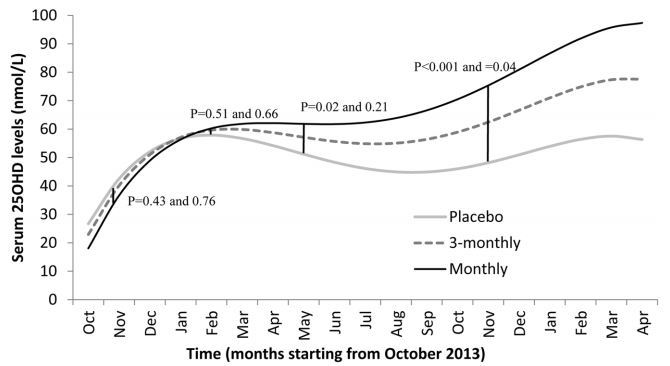Monthly Vitamin D had a 20 percent better response than quarterly – small RCT
The optimal dosage regimen of vitamin D supplementation for correcting deficiency in adolescents: a pilot randomized controlled trial.
Eur J Clin Nutr. 2018 Apr;72(4):534-540. doi: 10.1038/s41430-018-0098-x.
Wu F1, Xiao C1, Aitken D1, Jones G1, Winzenberg T2,3.
 * Which agrees with this study: quarterly is not as good as monthly
* Which agrees with this study: quarterly is not as good as monthly
📄 Download the PDF from Sci-Hub via VitaminDWiki

"Seasonally corrected" Vitamin D levels

Very strange that the placebo group almost doubled in 12 months
Perhaps the title for this page should be: Take a placebo if you want to double your vitamin D levels
BACKGROUND/OBJECTIVES:
Vitamin D deficiency is common in adolescents but the optimal dosage regimen for correcting deficiency is unknown. To test the safety and efficacy of two different vitamin D dosage regimens to correct vitamin D deficiency in adolescents.
SUBJECTS/METHODS:
In this 12-month, double-blind, randomized placebo-controlled trial, 28 adolescents (serum 25 hydroxyvitamin D (25(OH)D) of 21 to 50 nmol/L) were randomly assigned to one of three groups: monthly (n = 9; vitamin D3 50,000 IU orally monthly plus three placebo tablets 3-monthly), 3-monthly (n = 9; 150,000 IU (3 × 50,000 IU tablets) 3-monthly and placebo orally monthly), or placebo (n = 10; placebo monthly and three placebo tablets 3-monthly). Serum 25(OH)D was measured at baseline, 3, 6 and 12 months.
RESULTS:
Two participants withdrew after their baseline measurement from the 3-monthly group. At 12 months, one participant was deficient (≤50 nmol/L) in both the monthly and 3-monthly groups, whereas six out of ten in the placebo remained deficient (P = 0.055). At 12 months, the average serum 25(OH)D levels for the monthly, 3-monthly and placebo groups were 76.4, 64.7 and 49.7 nmol/L, respectively (P < 0.001 and P = 0.04 for differences between monthly and placebo groups and 3-monthly and placebo groups respectively, after adjustment for age, sex and seasonal variation). Adherence was 100% and adverse events were minor.
CONCLUSIONS:
Both 50,000 IU monthly and 150,000 IU 3-monthly of vitamin D3 safely and effectively corrects vitamin D deficiency in adolescents. These data provide treatment options which can be used by health practitioners to tailor vitamin D dosage regiments according to patient preference and context.
